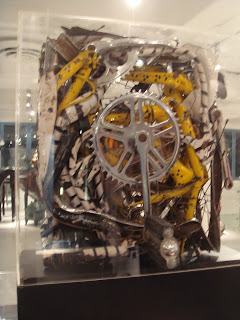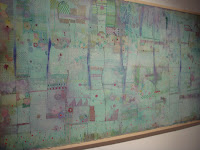
In the new Al Sabah design and art space, on the second floor, "the souk", between dresses, sandals and other furniture, was an interesting sculpture.
The crushed Bicycle
(the footnote says: This piece, by Indian artist Kiran Varia, once has a life bustling along traffic in Mumbai. The crushed bicycle now contained in the rigid shape of a display case demonstrates questions about art and where it can be found).
These same questions where asked by the french Artist Cesar and his compression period in the early 60's along his full work as a sculptor, painter etc.. Cesar was fascinated by the elements of life and incorporated them. He went to junk yards, used material and saw in action hydraulic crushing machines. He experimented with cars to cans, jewelry etc..
He was part of the 60's movement "Les nouveaux realistes" who found inspiration in urban life. It came along the same time as the Pop Art movement of New York. According to Pierre Restang, member of "les nouveaux realistes" : "appropriation of reality as a poetic recycling of urban, industrial and advertising reality".
In the Arab world, a giant sculpture by Cesar showing piled tanks with concrete sealer can be seen in Lebanon, Fayadiyeh, Ministry of Defense's entrance as a tribute to the many wars in the country.The crushed Bicycle
(the footnote says: This piece, by Indian artist Kiran Varia, once has a life bustling along traffic in Mumbai. The crushed bicycle now contained in the rigid shape of a display case demonstrates questions about art and where it can be found).
These same questions where asked by the french Artist Cesar and his compression period in the early 60's along his full work as a sculptor, painter etc.. Cesar was fascinated by the elements of life and incorporated them. He went to junk yards, used material and saw in action hydraulic crushing machines. He experimented with cars to cans, jewelry etc..
He was part of the 60's movement "Les nouveaux realistes" who found inspiration in urban life. It came along the same time as the Pop Art movement of New York. According to Pierre Restang, member of "les nouveaux realistes" : "appropriation of reality as a poetic recycling of urban, industrial and advertising reality".




















